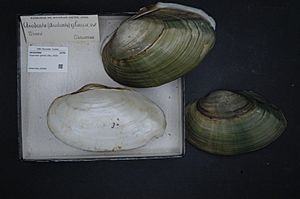Giant floater facts for kids
Quick facts for kids Giant floater |
|
|---|---|
 |
|
| Scientific classification | |
| Genus: |
Pyganodon
|
| Species: |
grandis
|
The giant floater (Pyganodon grandis) is a type of freshwater mussel. It is an aquatic bivalve mollusk that lives in rivers and lakes. These mussels are known for growing quickly and reaching a large size. They are part of the Unionidae family, often called "river mussels."
Contents
Understanding the Giant Floater Mussel
The giant floater is a fascinating creature that plays an important role in freshwater ecosystems. Like other mussels, it has a soft body protected by two hard shells. These shells are connected by a hinge, allowing the mussel to open and close them.
What is a Bivalve Mollusk?
A bivalve is a type of mollusk that has two shells. Think of clams, oysters, and scallops; they are all bivalves too. The word "bivalve" means "two shells." These shells help protect the soft body of the animal inside. Mussels use their shells to hide from predators and to filter water.
How Long Do Giant Floaters Live?
Giant floaters are known for having a relatively short lifespan compared to some other mussel species. While some mussels can live for many decades, giant floaters typically live for a shorter period, often around 10 to 15 years. However, they grow very fast during their lives.
Where Giant Floater Mussels Live
The giant floater mussel is native to North America. This means it naturally lives in this part of the world.
Their Home in North America
You can find giant floater mussels across a wide area of the United States. They are also common in southeastern Canada. They prefer to live in freshwater environments such as:
- Rivers
- Lakes
- Ponds
- Streams
They usually live on the bottom of these water bodies, often buried partly in the mud or sand.
What Giant Floater Mussels Look Like
The giant floater gets its name because it can grow quite large. Its shell has some unique features that help identify it.
Shell Characteristics
The shell of a giant floater mussel is typically:
- Very large: It can be one of the biggest freshwater mussels you might find.
- Shape: It often has an oval or slightly rounded shape.
- Color: The outside of the shell is usually a dark yellowish-brown color.
- Texture: The shell often has uneven wrinkles and wavy patterns across its surface. These patterns can make each mussel look a bit different.
- Inside the Shell: If you look inside the shell, it is usually white. Sometimes, the edges, especially near the front, might have a dusky or darker color.
The Umbo and Beak
The umbo is the oldest part of the mussel's shell, located near the hinge. In giant floaters, the umbo is slightly raised. The "beak" of the shell, which is part of the umbo, often has a few small, wavy, sharp bumps. These features are important for scientists when identifying different mussel species.
The Life Cycle of a Freshwater Mussel
Freshwater mussels, including the giant floater, have a unique and interesting life cycle that often involves fish.
Reproduction
Female mussels release their larvae, called glochidia, into the water. These glochidia are tiny and need to attach to the gills or fins of a specific type of fish to develop further. This temporary attachment does not usually harm the fish. The fish acts as a host, helping the young mussels travel to new areas.
From Larva to Adult
After a period of growth on the fish, the glochidia transform into tiny juvenile mussels. They then detach from the fish and fall to the bottom of the river or lake. Once on the bottom, they burrow into the sediment and begin to grow into adult mussels, filtering water and living their lives.
The Role of Mussels in Nature
Giant floater mussels, like other freshwater mussels, are very important for the health of aquatic environments.
Natural Water Filters
Mussels are often called "nature's water filters." They feed by drawing water into their shells and filtering out tiny particles like algae, bacteria, and other organic matter. This process helps to:
- Clean the water
- Improve water clarity
- Remove pollutants from the water
By filtering water, mussels help create a healthier environment for other aquatic animals and plants.
Food Source and Habitat
Mussels can also be a food source for some animals, such as muskrats, raccoons, and certain birds. Their shells can also provide a stable surface for other small aquatic creatures to live on.
Indicators of Water Health
Because mussels are sensitive to changes in water quality, they are often used as "bioindicators." If mussel populations are healthy and thriving, it usually means the water quality in that area is good. A decline in mussel numbers can be a warning sign that the water is becoming polluted or unhealthy.

